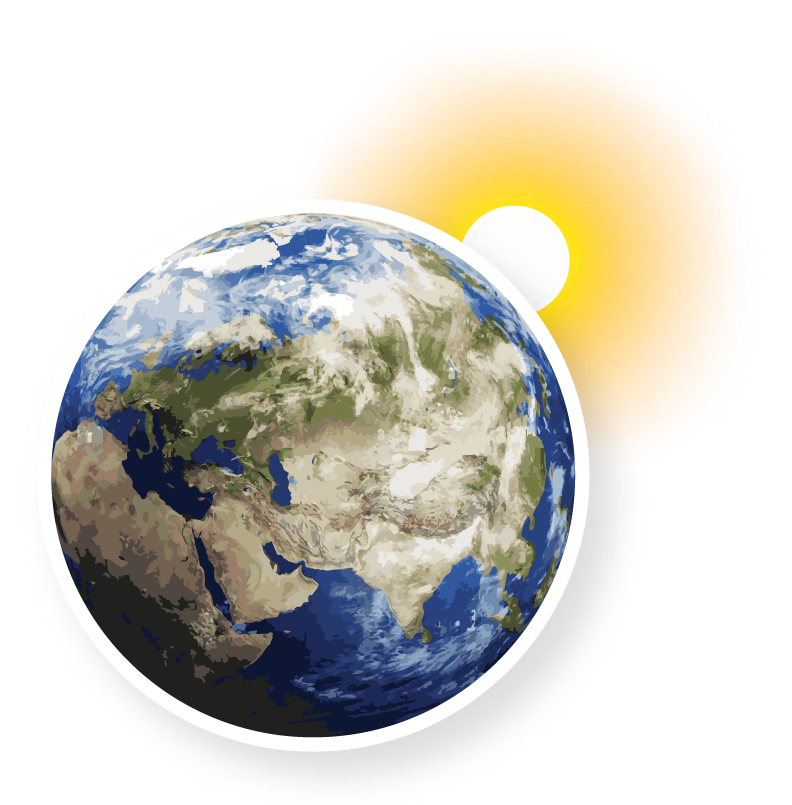Climate change is one of the most urgent global issues of our time. Thirty years ago, only scientists talked about climate change, but today it concerns most of us. We notice that the weather has become warmer and is increasingly hard to predict at any time of the year. We also notice the increased frequency and severity of extreme events, such as storms, hurricanes, heatwaves, precipitation, and droughts.
The fact that our planet’s climate is changing, and changing rapidly, is clear beyond doubt. Judge for yourself: since the second half of the 19th century till this decade, the average temperature on Earth has risen by nearly 1.2°C. That may not seem like much, but on a global scale it poses a serious threat to all life on our planet, from plants to animals and to ourselves. And keep in mind that nearly 1.2°C is the world average, but warming is stronger over land than in ocean, and strongest in the Arctic. Warming is also stronger in the northern hemisphere than in the southern hemisphere, whose larger surface area absorbs more solar radiation and ocean circulation. Warming has also occurred at a faster rate after the 1970s than in the first half of the 21st century.
Figure 1.1 Map of observed changes in surface temperature on Earth between 1901 and 2022

The Earth is getting hotter
According to the World Meteorological Organization, the global average temperature on Earth in 2023 was about 1.4°C above the 1850-1900 average. This means that 2023 was the warmest year since record-keeping began in 1850.
The Greek philosopher Heraclitus coined the phrase ‘panta rhey’ (everything flows) to express the concept of change. This also applies to the climate, which has been constantly changing for millions of years. Even 125 million years ago, global average temperatures were higher by about 1°C than they are today.
But the rapid rate of climate change in recent decades has perilous consequences for the planet and all its inhabitants.
‘Climate change’ is a more accurate term than ‘global warming’ because higher temperatures are only a part of what climate change means for Earth. Changes in climate lead to a loss of equilibrium throughout the natural world: glaciers and permafrost are melting, sea levels are rising, floods, droughts and hurricanes are more frequent, and the weather is harder to predict. Climate change leads to the extinction of many animals and plants, which cannot adapt to the new conditions, it hurts countries’ economies and threatens the health and the lives of people.
There are different theories of why these changes are happening. Some researchers say they are due to the impact of astronomical processes (increased solar activity and changes in the slope of the Earth’s axis), while others say that climate problems are a result of excessive human consumption of natural resources. What is certain is that solar activity and changes in the slope of the Earth’s axis are beyond our control, while excessive consumption and the climate-harming greenhouse gases it causes are things we can do something about.
There is no country that is not experiencing the drastic effects of climate change. Greenhouse gas (GHG) emissions in the atmosphere are more than 50% higher than in 1990. Increasing GHG emissions are causing long-lasting changes to our climate system, which threatens irreversible consequences if we do not act.

The Intergovernmental Panel on Climate Change and its most recent findings
The Intergovernmental Panel on Climate Change (IPCC) is an intergovernmental body of the United Nations. The IPCC was created in 1988 by the World Meteorological Organization and the United Nations Environment Programme to advance scientific knowledge and understanding of climate change, its drivers, and consequences, and how to deal with it.
The IPCC provides governments with the most updated scientific information on climate change. It does not conduct its own research but assesses all relevant scientific literature. This includes the observed changes in the climate system and their projections; natural, economic, and social impacts and risks stemming from climate change, and options and opportunities to mitigate climate change and adapt to its consequences. Thousands of scientists and other experts volunteer to review huge volumes of publications and reflect their findings in ‘Assessment Reports’ for policymakers and the public.
The IPCC is the most authoritative source of scientific information and assessment on climate change as leading climate scientists and governments endorse its findings. IPCC reports play a key role in the annual climate Conferences of the Parties to the United Nations Framework Convention on Climate Change (UNFCCC) that are known as COPs. Each of the six Assessment Reports (AR) published by the IPCC has led to major advances in UNFCCC negotiations. The First Assessment Report was critical to the negotiations that led to the adoption of the UNFCCC in 1992, the Second Assessment Report to negotiations of the Kyoto Protocol in 1997 and the Fifth Assessment Report to negotiations of the landmark Paris Agreement in 2015.
The most recent report by the IPCC is its Sixth Assessment Report (AR6) published in 2021- 2023. Many of its findings are in this edition of the Climate Box (Fig. 1.2).
Figure 1.2 Highlights of key messages from the IPCC AR6

“It is indisputable that human activities are causing climate change, making extreme climate change events, including heat waves, heavy rainfall, and droughts, more frequent and severe.”
“The evidence is clear: the time for action is now.”
You can find more at:
So, what is really happening to our weather and climate? How did the Earth’s climate change in the past and how is it changing now? What is to blame for the changes that are happening? What are greenhouse gases and what can we do about them? Let’s try to find some answers to these questions.



